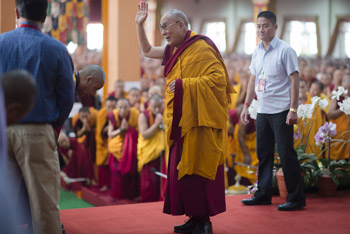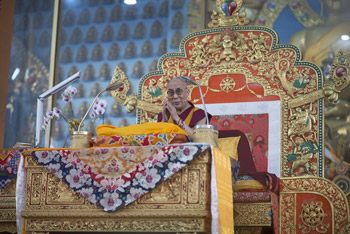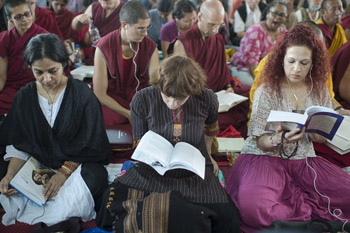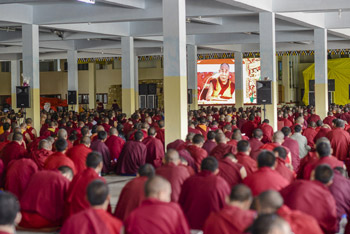Mundgod, Karnataka, India, 24 December 2014 - “In this prayer that the Lama recites it says there’s nothing better to listen to,” said His Holiness the Dalai Lama at the start of the second day of the ‘Stages of the Path’ teachings he is giving at Ganden Jangtse Monastery, “than the sound of the teachings that quell our emotions. These teachings not only point out the emotions that disturb our minds, but also how to counter them. We don’t want suffering and as human beings we can use our intelligence to avert it. Language can be used in different ways. We should use it to benefit. The spiritual teaching that helps us tame our unruly minds is the teaching of the Buddha.

|
His Holiness the Dalai Lama waving to the audience at the start of the second day of his teachings at Ganden Jangtse Monastery in Mundgod, India on December 24, 2014. Photo/Tenzin Choejor/OHHDL
|
“The nature of the mind is luminous and aware. Knowing that, we can remove the adventitious defilements, the disturbing emotions, that are our real enemy. The Buddha was able to perform miracles, but it’s through his speech that he was able to help us learn to deal with our emotions. Over the 2600 years since he taught in India, many have been led to liberation and enlightenment. They overcame the obstructions to knowledge and attained Buddhahood.”
His Holiness remarked that material development alone is not a path to happiness. We need to know the source of suffering and the disturbances that afflict us and how to put a stop to it. Je Tsongkhapa said that of all the Buddha’s deeds his speech was pre-eminent and of all his teachings the most effective was dependent arising. His Holiness added that while it is good to recite the Heart Sutra, as had just been done, it is more important to know what it means. As it says, all the Buddhas of the three times have depended on the perfection of wisdom. Moreover, love and compassion are effective at countering anger, but are ineffective in countering ignorance.
The Heart Sutra clarifies that not only is the person empty of intrinsic existence, but the aggregates are also empty. Form has no objective existence. As the sevenfold analysis of a chariot demonstrates, things exist only by way of designation. This, Je Tsongkhapa says, is the difficult point.
“I make no claim to have realised emptiness,” His Holiness declared, “but I think I can say I’m on the verge of doing so. Although things lack inherent existence, we can’t deny that they exist at all.”
In connection with a meeting of the International Gelugpa Association that is to take place tomorrow, His Holiness told the assembly that he had already talked to Tri Rinpoche, Abbots and former Abbots about what needs to be done. He made the point that whereas in the past monks would talk about their studies in their spare time, nowadays they are more likely to talk about the latest movie. On the other hand study is more widespread than before. Monasteries that used to focus on rituals now provide opportunities to study.
With His Holiness’s encouragement nuns have been studying hard. Consequently there are now nuns about to earn their Geshema degrees. People have asked if that is possible and His Holiness said he has replied that if there are Gelongs there can be Gelongmas and since there are Geshes, Geshemas are possible too.

|
His Holiness the Dalai Lama during the second day of his teachings at Ganden Jangtse Monastery in Mundgod, India on December 24, 2014. Photo/Tenzin Choejor/OHHDL
|
While encouraging his listeners to consider what they will discuss tomorrow, he hoped that their meeting would not be like the World Parliament of Religions which he has found to be a sleepy occasion.
“Too often we try to ignore our shortcomings. In 1956 I was in India and told Pandit Nehru I wanted to stay. He however advised me to go back to Lhasa. When we reached Dromo I told those who met me that what we had to do was discuss our shortcomings and let others concern themselves with our good qualities. This also applies to your meeting tomorrow.
“We have to ask why so few students from the Tibetan exile community are joining the monasteries these days. There are some from Tibet and many from the Transhimalayan region. Meanwhile I have been encouraging students in secular schools to study logic and debate, which I hope will encourage them and give them something to be proud of. Don’t be like the Jokhang caretaker who sat back while someone ate the offerings and a fire broke out in one of the chapels.”
Opening ‘Zhamar Pandita’s Treatise on the Stages of the Path to Enlightenment’ which describes the seven limb practice His Holiness said that when it comes to making offerings, the best is your own practice. When it came to the limb about requesting the Buddhas to teach the Dharma, he suggested the Buddha would be justified in saying he had already done that. The teachings he gave comprise the Kangyur collection. He said Gyen Nyima Gyeltsen and Tongpön Rinpoche are among the few people he knew who would actually read those volumes.
Reaching a point in the ‘Zhamar Lam Rim’ that mentions renunciation or cultivating a determination to be free, His Holiness suggested reciting Je Tsongkhapa’s short text ‘Foundation of All Excellence’ supplemented by verses from the ‘Three Principal Aspects of the Path’.
“The door to all misery is seeking satisfaction in pleasure.
Having realized that there is no security
In the pernicious perfections of cyclic existence,
May I be strongly intent on the bliss of liberation.
Swept by the current of the four powerful rivers,
Tied by strong bonds of actions, so hard to undo,
Caught in the iron net of self-centredness,
Completely enveloped by the darkness of ignorance,
Born and reborn in boundless cyclic existence,
Ceaselessly tormented by the three miseries
This is the condition I am in.
Thus, from the outset I seek a determination to be free.”

|
Members of the audience following the text during the second day of His Holiness the Dalai Lama's teachings at Ganden Jangtse Monastery in Mundgod, India on December 24, 2014. Photo/Tenzin Choejor/OHHDL
|
The description of visualizing your lama surrounded by lamas of other traditions prompted His Holiness to express his dismay about the sectarianism that had existed in Tibet. He said he considers it an aspect of narrow-mindedness. As he opened ‘Liberation in the Palm of Your Hand’ he told the story of how he had made an active decision to be more ecumenical. Many years ago, an elderly man approached His Holiness with a request for the teaching introducing the nature of the mind from the Kagyu Mahamudra. He was very uneasy at having to turn the request down because he wasn’t able to fulfil it. He sent the man to Khunu Lama Rinpoche who was still alive. In due course he received many lineages and empowerments from the other Tibetan traditions from Dilgo Khyentse Rinpoche, Chopgye Trichen Rinpoche and others.
His Holiness began the afternoon session saying:
“Identifying the disease of the disturbing emotions is crucial. Not many spiritual traditions concern themselves with this, but the ancient Indian traditions that include the practices of Shamatha and Vipasyana have an inkling of it. They tend to have an understanding of the mind and its functions. At the VHP congress I was recently invited to I made a point of drawing attention to the debates between opposing points of view that used to take place, to mutual benefit, in places like the University of Nalanda. I encouraged them to revisit their ancient inheritance.”
He spoke about the voluntary science programme that has been introduced over the last 10 years in the monasteries. He quoted the admiration many of the young science teachers have expressed for the monastics. Despite problems of language and vastly different educational backgrounds they found the monks have a strongly reasoned approach and robust deductive powers.

|
Some of the may thousands of gathered monks watching His Holiness the Dalai Lama on a big screen during the second day of his teachings at Ganden Jangtse Monastery in Mundgod, India on December 24, 2014. Photo/Tenzin Choejor/OHHDL
|
In contrast to this he said that increasingly today people fail to see their disturbing emotions as negative.
“Look at those who follow Dolgyal,” he said. “I feel sorry for their being full of misconceptions and misunderstanding. I’ve given my advice, but they don’t listen to it. If we consider ourselves followers of Je Tsongkhapa, we should be unbiased and follow reason. But if even the Buddha couldn’t command others to do something, who am I to do so?”
Reminding his listeners that Buddhists study to attain enlightenment, not just to earn degrees, he noted that there are teachers who complete their training and teach others. In the course of this their knowledge improves. He also noted that it is the kindness of teachers appearing in an ordinary form that allows us to receive teachings from them.
His Holiness will continue to read the two ‘Stages of the Path’ texts tomorrow.